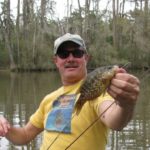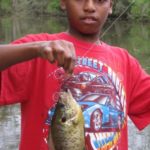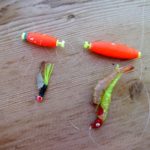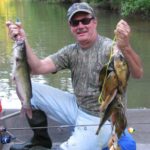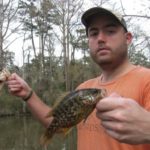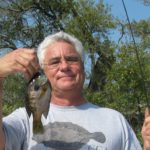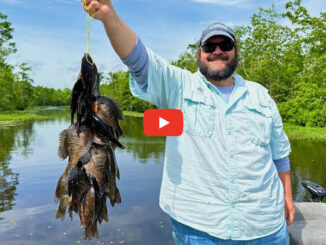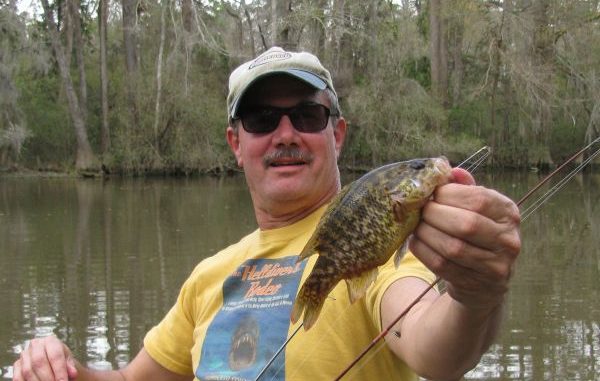
If you need something to add to your next get-together, a quick fishing trip to Bayou Lacombe can provide enough meat for some delicious fried-fish sandwiches.
You know how it goes: After slurping through a few pounds of spicy boiled crawfish you start craving a something a little heavier and crunchier.
Fried fish is just the ticket to slake this craving — especially when it comes in the form of an overstuffed po-boy.
More importantly, crawfish prices were still high and Doc had scrimped a bit on the poundage for his traditional St. Patrick’s Day boil, not knowing the crowd would actually be bigger than usual with Pelayo’s brother “On-The-Ball” Paul and his family visiting from Atlanta.
“No problemo!” Artie declared. “We’ll take up the slack with fish po-boys! They always go great with boiled crawfish!”
Alas — as always happens this year — all our fish stocks were low. As usual, our out-of-town friends and family had made off with most of the bags of chunky sheepshead fillets from Mardi Gras week. They can’t get enough.
Now we were scrimping for our own parties.
Worse, high river levels (the Amite, Tickfaw, Tangipahoa, Tchefuncte and — most importantly — Pearl rivers) were playing havoc with the salinity in Lake Pontchartrain.
“Forget specs at the trestles!” Artie blurted. “You gotta be outcha mind! Ain’t nothing but fresh waaaw-da right now.
“Try choupique or gaspergou — maybe.”
Well, when life hands you fresh “waaaw-da” in the Lake Pontchartrain basin, we always say, adapt.
“But I heard da lake runners were runnin’ round Slidell,” Artie quickly added. “Don’t take many of them to stuff a few po-boys!”
Here’s another entry for Benny Grunch and Da Bunch’s classic about bygone New Orleans titled It Ain’t Dere No More. I refer to the phrase (rather than the activity itself) because “da lake runners” (aka redeared sunfish) are still “dere” (in the fresh to slightly brackish marshes surrounding northern and eastern Lake Pontchartrain.)
And they still “run” (spawn and bite) in early spring.
Interestingly, this fish tolerates salinity levels of up to 5 or 6 parts per thousand, which explains why they’ve always been plentiful in the fresh to brackish marshes around Lake Pontchartrain.
It also explains why we often catch rat reds and flounder in conjunction with them.
But you don’t hear of many people targeting “lake runners” anymore, at least in the New Orleans area, where heading over to the Chef or Slidell area in small boats with grass shrimp was a traditional late-winter/early spring fishing rite.
And there was a good reason for this timing.
Redears are among the first panfish to spawn. They usually start building beds when the water reaches about 68 degrees.
Bluegills (that other “perch”), on the other hand, usually wait until water temperatures hit around 75.
Of course, this doesn’t mean you won’t catch both of them from the same spot, along with chunky goggle-eyes, channel cats, yellow bass (aka barfish) and “green-trout.”
Just because fish aren’t spawning doesn’t mean they’re not biting. Funny how it’s mostly fresh water panfish that we target almost exclusively when spawning. Don’t they eat year round?
Whoever heard, for instance, of waiting for redfish to spawn before targeting them?
Instead, we prowl around the marsh scouting for likely looking feeding areas were reds might be congregating or prowling around.
Well, the same holds for perch fishing. Some of the biggest catches of bluegills, lake runners, sac-a-lait, goggle-eye, channel cats and green-trout (aka bass) I’ve seen in the Lake Pontchartrain basin area have been in Late February and March — well before any of these fish are in full spawning mode.
Instead they’re simply in an eating mode.
Redears seem to prefer small crustaceans (grass shrimp, tiny crawfish) over anything else — not that they exactly shun worms and crickets
Goggle-eye (technically known as warmouths) also spawn in relatively cool water, usually a bit later than redears and before bluegills. They’ll take any of the classic panfish jigs or baits but aren’t as sociable as other panfish. It usually takes a little moving around to catch a mess, which explains why most fishermen catch them incidental to bluegill or even bass fishing.
Bluegill are the last to start spawning. They’ll hit the beds when the water reaches around 75 degrees — late May to early July in South Louisiana.
These timetables, of course, aren’t etched in stone. Any perch fishing trip usually nets a combination of the three, with maybe bluegills in the majority.
But what all of these fish have in common when spawning is a preference for sandy, gravelly bottoms studded with plenty of stumps, logs and submerged weeds.
“Panfishing central” is what we call the Bayou Lacombe area and its adjacent lakeshore cuts, ponds, bayous (such as Bayou Bonfouca) and lagoons. For reliability in producing the makings of a panfish fry, few early spring-late winter fishing spots can match it — and none that I know along the North Shore.
First off, it’s a bona fide “bayou” among rivers.
The East, Middle and West Pearl rivers all lie to its east. The Tchefuncte, Bogue Falaya, Bogue Chitto, Tangipahoa, Blood, Tickfaw and Amite rivers all lie to its west.
These rivers typically originate much farther north than Bayou Lacombe, and drain a larger amount of land, especially the Pearl. This means they’re much more prone to flood stages in the spring, hence turbidity, hence lousy fishing.
I shouldn’t say “lousy:” more like “undependable.” Any downpour north of us renders the water high and murky.
But Bayou Lacombe is a mere trickle just north of I-12. It’s a relatively short, sluggish stream. So panfish turn on here at about the same time as in the other short, sluggish bayous south and west of Lake Pontchartrain — places like Pier 90, Des Allemands, the 51 Canal and Manchac.
In my experience, the best panfishing in the Pearl River system peaks in June, when the water’s finally down, clearing up and warming up. That’s when the bluegill, lake runners, cats and yellow bass go into their feeding frenzies.
The Tchefuncte, Bogue Chitto and Tangipahoa turn on a little earlier, mid- to late May, at least in my experience.
Not that you won’t catch good numbers of panfish a little earlier and a little later; it’s just that they’re more predictable in early summer.
But what we call “the north shore basin” (marshes around Bayou Lacombe/Bonfouca, Madisonville rice fields) always seem to turn on much earlier.
For fish-fry connoisseurs, the variety of fish has a lot to do with this area’s predictability. Lake runners, bluegill, yellow bass, white bass, green trout, channel cats, blue cats, goggle-eye, the odd sheepshead, flounder or redfish — if one species isn’t running, a couple of the others usually take up the slack.
Lake runners and bluegills down with lockjaw from a water-roiling downpour? No sweat: Go a little deeper with maaaw-ket shrimp, chicken livers or worms, and target channel cats.
The little stripers (yellow bass, technically) haven’t started their run, or ended it abruptly? Well, the bluegill might just be starting their spawn or simply be hungry.
Lake runners scarce? Wait until dusk. That’s when the dinner bell always seems to go off for north-shore goggle-eye. They emerge and start hammering your grass shrimp and little crawfish, especially if you cast right to the edge of the grass line, with the bait 3 feet under a little cork.
There are many options in this area for early spring panfishing.
The marsh section of Bayou Lacombe (the one from the lake shore to the tree line) often yields nice baskets, boxes or — in the case of many bank fishermen — bucketfuls of any combination of these panfish.
We launched Pelayo’s flatboat after picking up the Big Branch NWR permits at the launch — don’t forget that most of the lake-shore marsh from Bayou Cane in the west to Highway 90 in the east is within the national wildlife refuge — and hung a left into the bayou itself, and then hung a right into the lagoon-pocked marsh, where we netted up grass shrimp along the grass-choked bank.
These shrimp are usually pretty small this time of year, so we spent more time than usual netting them. We’d be threading two, maybe three of them on the hook at a time.
Then we found a deep slough that emptied into the bayou, and beached the flatboat. Like most of these cuts, it’s fairly shallow at the mouth; then it drops down to over 6-foot depths — especially in the bends — as it starts winding into the marsh.
Pelayo was already threading on two grass shrimp as I baited up with a piece of maaaw-ket shrimp on my mini-jig. Generally speaking, there’s no topping grass shrimp for this type of fishing. Yes, worms often work, as well. And crickets work, too.
But they don’t yield the variety of fish that grass shrimp entice. I mean, out here you’ll catch bluegill, lake runners, goggl-eye, yellow bass, green trout, barfish, catfish and — well, you get the idea.
“Whoah!” I blurted. “Whatcha got?”
Pelayo’s cork hadn’t bobbed twice near an eddy when it vanished and his tiny spinning reel started screeching.
“One heck of a panfish here!“ Pelayo roared, just as it frothed the surface.
Then it made another spirited run along the bank. Some more bulldog tugging. Now another torpedo run across to the other side.
“If I didn’t know better,” Artie said. “I’d say it’s fighting like a — yep! It’s a redfish! Saw his tail.”
A red, indeed. Nothing huge: maybe a 3-pounder. But on ultra-light spinning tackle geared for 7-inch fish, it was more than a match.
Like I was saying — variety. You never know what you’ll catch on grass shrimp out here.
I rigged my elaborate jig: a mini-jig tipped with a deceased shrimp and two split shots 4 feet under a little Styrofoam bobber. It’s the same principle as saltwater marsh fishing, but with everything scaled down.
The offering was then cast to that hole near the slough’s bend.
“Water’s still kinda cold,” I mused. “They’re probably hanging deep.”
Fifteen minutes later, I hadn’t gotten a bite. But Artie had hauled in a yellow bass, two lake runners and a goggle-eye, making sure to look my way and gloat with every crank of his reel.
He’d been casting toward the shallower water with grass shrimp — against my advice.
“Watch-OUT!” Pelayo yelled as he reared back on his ultra-light rod. “Another one here!”
“Not another red, huh?” I gasped. “Looks like ….”
Nope. In seconds it was rolling on the surface — a nice channel cat.
“Where’d you cast?” I asked.
“Right over there,” he pointed with his pole.
It was a shallow flat, the kind that forms opposite the bends. I cast toward it with my cork adjusted to 2 feet and quickly latched onto a chunky bluegill.
On the following cast the cork plunged, I struck and the fish went airborne. I finally swung aboard a little largemouth bass whose size and shape perfectly illustrated why New Orleans area folks (so familiar with school specs) christened them “green-trout.”
Artie landed another lively one almost instantly.
Then they shut off, and we moved down 100 yards or so to where two big duck ponds drained into the slough. A front with northwesterly winds two days earlier still had the water plummeting. The ripples from the current almost formed rapids as they converged over the shallow water.
“Cast over there, Artie,” I instructed while pointing toward the deeper, calmer water.
Something was smacking the water there, maybe more green-trout or barfish feeding on shiners. So, naturally, Artie made a point of frowning at me and casting his pair of grass shrimp in the opposite direction, toward the shallow “rapids.”
His cork hit the water and started racing with the current.
“Check it out,” I nodded. “Can’t fish there. Too much current and dirty water.”
Just then Artie’s cork slowed down and started sinking. In seconds Artie set the hook and his little reel’s drag started singing.
The water erupted, and his pole bowed. A gorgeous dark-hued male bluegill was soon swung aboard, followed by a chunky goggle-eye that would yield some nice little fillets for the po-boys.
And then Pelayo whooped as he reared back on his little rod. A nice wake was plowing toward the deeper water, and then the fish rolled on the surface. Then more of the dogged back-and-forth tugging characteristic of — yep — a perfectly sized (for filleting) channel cat.
“Heck, we’re already close to a fish fry,” Artie said as he netted his own catfish.
Finally, my little cork plunged. Instantly, the fish hit the surface. Then made a long run. Then rolled on the surface again.
“Man, that’s another thing I love about these channel cats,” I whooped, savoring the battle. “They fight nothing like hardheads!”
“More like rat reds,” Pelayo quickly added.
“Here’s half a po-boy right here!” I whooped as the catfish gasped and flopped on the floor of the flatboat.
We caught eight channel cats in that one place. None under 1 ½ pounds; none over 3.
They hit grass shrimp and the leftover market shrimp we brought along — nice and ripe after a month in the freezer.
The water was still fairly cold. So we were kinda surprised. We’d expected more of a lakerunner perch trip.
Catfish are supposed to be deep this time of year. At Pass Manchac, for instance, you catch them at 40 and 50 feet this time of year.
But the more we thought about it, the more sense it started to make.
The water was still cold in the bayou itself, but those shallow duck ponds warm up quickly under the afternoon sun with no clouds.
So the water draining out of them into a deeper cut made a perfect fishing spot. And believe me, tangling with a 2 -pound channel cat on light spinning tackle in shallow water beats the heck out of cranking them up from the bottom of Pass Manchac.
A similar pattern occurs at the rice fields in Madisonville every early spring. When the water from the rice fields —which are not really rice anymore but shallow ponds that warm by midday on sunny days — empties into the High Bridge Canal, you mop up on lake runners and bull bream near the drains.
We’ve seen it time and again. I guess the same principle applies here.
We ended up with 16 lake runners and bluegills, eight channel cats, four goggle eye, three green trout, two barfish and a red — a “box-a-mixed” for sure.
During low river levels, we’d be laughed out of any boat launch around the Atchafalaya Basin for boasting of such a skimpy catch. But for us, and especially for this time of year, it was something to gloat about.
And indeed, the four fried-fish po-boys dressed with Artie’s homemade tartar sauce were just the ticket to take up the slack at Doc’s St. Patrick’s day crawfish boil that night.
